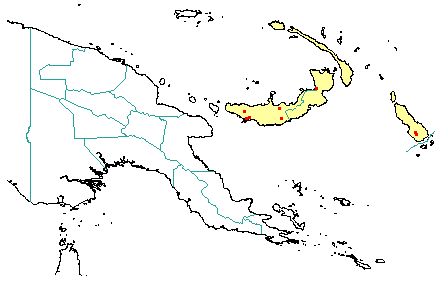
in PNGplants database
PNGTreesKey – Serianthes minahassae subsp. fosbergii Kanis |
Barry Conn (NSW) & Kipiro Damas (LAE).
Guide to trees of Papua New Guinea
Copyright held by the authors, National Herbarium of New South Wales, and Papua New Guinea National Herbarium
Brunonia Vol. 2: 302 (1980)
Other Literature: I.C. Nielsen, Flora Malesiana, Series I 159 (1992)
Family: Fabaceae
Dicotyledon
Timber Group: Non-timber species
Field Characters: Emergent tree or Large canopy tree (25-35 m high); Bole cylindrical (60-70 cm diam.); straight (bole 12-27 m long); buttresses buttresses present (buttresses up to 2 m high); spines spines absent; aerial roots aerial roots absent; stilt roots stilt roots absent; Bark grey, slightly rough or smooth, pustular, lenticels elongated vertically; Subrhytidome (under-bark) pale orange; less than 25 mm thick; bark blaze consisting of one layer; faintly to non-aromatic or strongly aromatic; onion-like (garlic-like); outer blaze pale yellow or pale brown, markings absent; inner blaze pale yellow or pale brown, markings absent; bark exudate (sap) present, colourless, not readily flowing (spotty), colour not changing on exposure to air, not sticky; terminal buds not enclosed by leaves.
Indumentum: Complex hairs absent; stinging hairs absent; mature twig indumentum (hairs) present, hairs dense to sparse.
Leaves: Leaves spaced along branches, spiral (leaves occurring singly at a node and arranged spirally up the branchlet), compound (a leaf made up from two or more leaflets); petiole present, not winged, attached to base of leaf blade, not swollen (however, petiole gland 2-4(-5) mm long, elliptic, raised and concave on top); leaves bipinnate (with the rachis branched once); petiolule swollen (slightly (at base, slightly pulvinus-like); rachis present, absent, absent; leaves without a terminal leaflet (the number of leaflets even - paripinnate), equally broad throughout much of length, 0.5-1.0 cm, 0.2-0.4 cm, leaflets opposite (only distal pair of pinnae) to leaflets alternate, asymmetric; venation pinnate (with mid-vein sub-central or at a distance of 1/3 the width to one margin), secondary veins open, not prominent, but visible, intramarginal veins absent; leaves lower surface pale green, upper surface dark green, indumentum (hairs) present (upper surface almost glabrous), indumentum (hairs) dense to sparse; absent; domatia absent; stipules absent (by misinterpretation because soon decidous) to present, free, laterally placed, not encircling the twig, hair-like to leafy (linear or filiform), not fringed, small, not persistent (only present in seedlings).
Flowers: Inflorescence axillary, flowers on a branched axis, cones absent; flowers bisexual, stalked, flowers with many planes of symmetry, (6.0-) 7.0-8.0 mm long, diameter small (up to10 mm diam.) (c. 7 mm diam.); perianth present, with distinct sepals and petals whorls, inner perianth white (especially on inside) or slightly green; 5, some or partly joined; stamens 100, present, joined (to form a staminal tube), joined to the perianth (staminal tube united with corolla); ovary superior, carpels joined (when more than one), locules 2; styles solitary, 1.
Fruits: Infrutescence arranged on branched axis, fruit 160.0-220.0 mm long, brown or black, not spiny, non-fleshy, simple, usually indehiscent or dehiscent, legume; seeds much more than 10 mm long (17-26 mm long), not winged, broad (as wide as long) (ellipsoid), seed 1-10 mm diam. (6.5-9 mm diam.).
Distribution: New Britain, New Ireland & Bougainville.
 | Botanical records in PNGplants database |
Notes: Notes This subspecies is classified in Fabaceae subfamily Mimosoideae or in the separate family Mimosaceae. Previously known as Albizia melanesica Fosb.